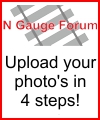- Welcome to N Gauge Forum.
Which Camera do You Use?Started by Mr Sprue, July 13, 2015, 02:01:46 PM Previous topic - Next topic0 Members and 1 Guest are viewing this topic.
User actions
| Please Support Us!
November Goal:
£100.00 Due Date: Nov 30 Total Receipts: £110.67 Above Goal: £10.67 Site Currency: GBP 111% November Donations |





